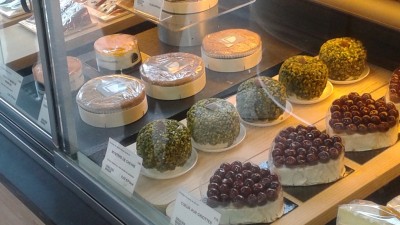
Fromage Is Basically a Religion in France (We Are Believers)
One of the things Paris is most well-known for is its markets, or marchés. There are over 80 of them in the city. One could make a whole trip to Paris, just around visiting marchés! We did a little research in the market book we brought from the states and choose Raspail Marché. It was the closest to us, it is fairly sizable, and it was one Dan tried to get to after school several times (since it was right outside his school) but didn’t, since it was closed by the time school let out.
First, we had a quick (by French standards) breakfast in the lobby of St Beuve. The lobby is converted into a dining area each morning. The funny thing was, we had a waiter with an extremely high, squeaky voice. Dan was down there first and I came down a few minutes later and each time I’d try to order something, he’s rapidly squeak something and run off. Dan translated, and basically, he’d ask me in French what I wanted and, since I didn’t answer right away, he’d squeak that he needed to go help someone else and then shuffle off there. It was puzzling but highly amusing.
Anyway, off we went to Raspail Marche. It runs down the center isle of the boulevard and goes for eight or so blocks. It is a mixture of clothing (pretty scarves and dresses) and crafts (jewelry, wood carvings) and many types of food. Produce, fromageries (cheese), charcuteries (cured meats), poissoneries (fish), patisseries (pastries), boulangeries (bread), and bucheries (butchers). Then some other food products that have been processed to some degree, like olives and pestos and herbal teas. All of the above, are foods that are mainstays for the French. They eat very little processed food (although as an aside, the McDonalds on Champs-Elysee is the most profitable McDonalds on the planet). Not that this is a detriment per se, but it’s interesting to note that a lot of the vendors do not appear to be the source of the food, which was my observation in Lyon as well. There is a wholesale market just outside of Paris, Rungis, where vendors can pick up the produce and then they go around from market to market to distribute it. In this way, this and other French marchés are somewhat of a cross between a farmer’s market, a supermarket, and a flea market. At the end of the day, we both loved it – the banter that happens between marché goers and vendors and fashionable people stocking up on goodies until they next visit a marché – the sheer variety of colors and shapes of things to feast our eyes on. It was a quintessential Paris experience.
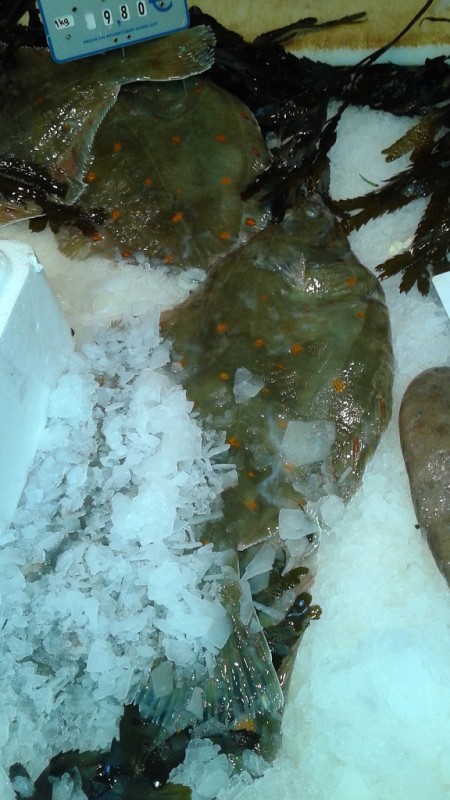
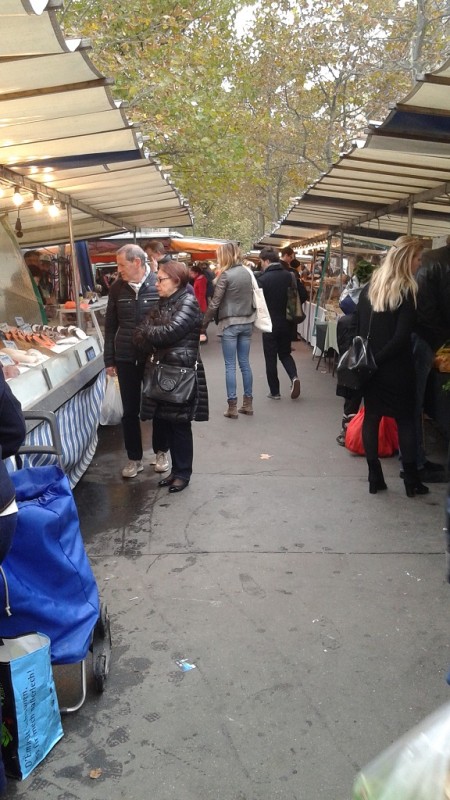
Raspail Marché
We were not too far from the St Germain outlet for Ducasse’s chocolate, so we walked over there. It was closed and it would be closed tomorrow. We checked online to see about the main factory, in the Bastille. It too would be closed until Tuesday morning. Now this closure, I was really bummed about. Dan had gotten some of his chocolate before I arrived, so I got to sample it – very creamy, not sweet (I like 85% cocoa), smooth texture, a complex flavor, without losing the essence of what it was meant to be. Now, there are chocolatiers up to wazoo in Paris. And we haven’t tried most of them, but just from looking, most of them are not up to snuff. Portland has amazing chocolate, importing the best from all over the world, so there is absolutely no reason for me to bring home anything less than the best from Paris. I took a flyer, and when I am back in the states, I will research to see if Ducasse’s chocolate is available.
After our frustrating stop at the closed Ducasse chocolate shop, walked to a cheese store, Laurent Dubois, in the Latin Quarter. I wasn’t going to take any risks about not being able to find cheese on Monday. Dan called to check that they could shrink wrap it, which preserves it a bit for traveling abroad. He had also been to this fromagerie before and could attest to the variety and quality. It was a small shop, yet they managed to provide a wide variety of choices. There were plenty of staff and everyone that walked in, was approached and asked if they needed help. For those of us who grew up knowing one type of cheese, the orange type that is individually wrapped in plastic, it is simply hard to comprehend not only the sheer variety in France, but the almost religious zeal for knowing all about what elements have come together to form any one particular type. I don’t want to get off on a tangent about all the elements (I’d need a whole other blog!), but suffice it to say, we thought we died and went to cheese heaven.
We were targeted and wanted to bring home cheese that we had experienced in different regions of France we had been to, this year and last year. St Maure from the Loire Valley (a cylinder of soft goat cheese with a blue mold on it and a piece of straw through it Trappe Échourgnac from the Dordogne (the cheese is somehow infused with walnuts, even though it is smooth with no residual nuts in it). Banon, we discovered this in Provence, and it is a cow cheese that is wrapped in chestnut leaves and tied with raffia). Sassenage or Bleu de Vercors, which is a blue cheese made not far from Lyon (we have actually not tried this one). And a house made truffled sheep cheese – talk about a delicious earthy taste. And finally, some Valençay, a classic goat’s milk cheese from central France.
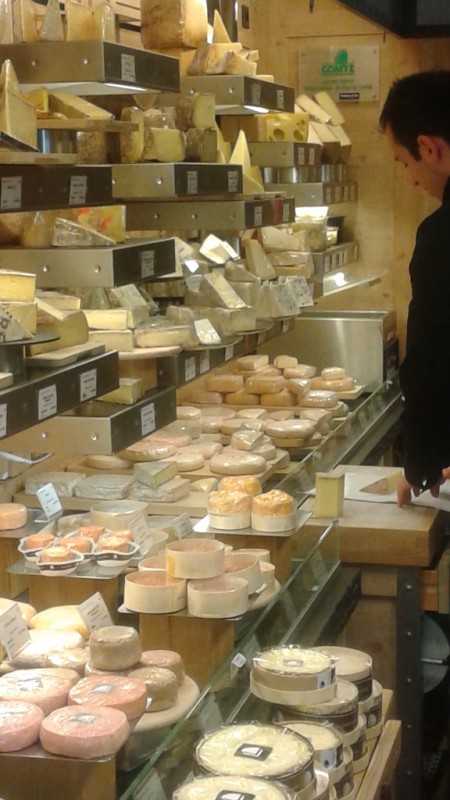
Oh My God — YUMMY!
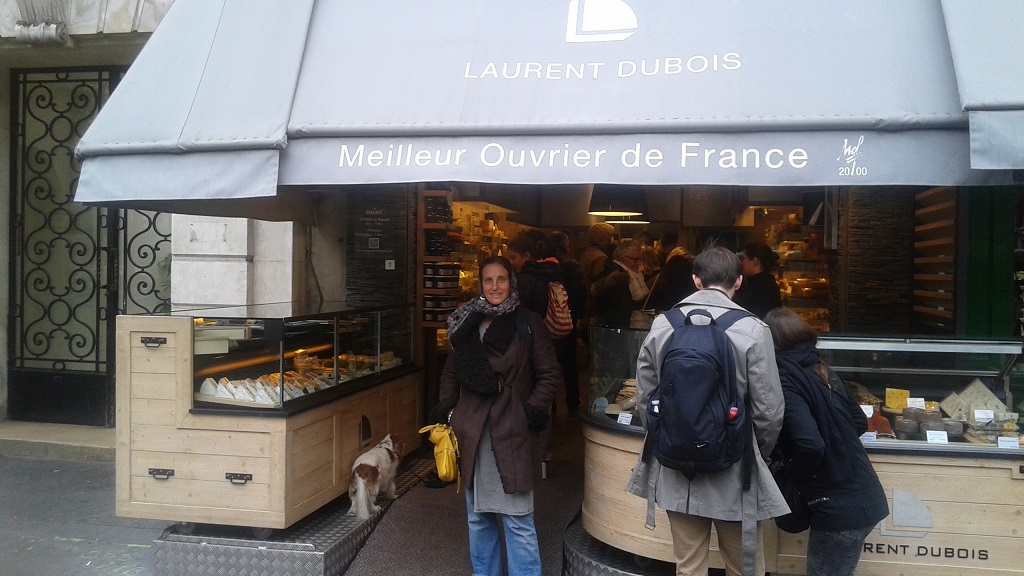
Laurent Dubois Is a Fromagerie in the Latin Quarter
From the cheese shop, we walked to Allard, which is also owned by Ducasse. Ducasse, we have determined, may not be THE best chef in the world, although he certainly is one of the best chefs in the world. But hands down, he is the most entrepreneurial chef in the world. He has his hands in seemingly, a million different food related operations. And furthermore, his restaurants are so different from each other. He fully embraces being an expansionist and visionary. And we are happy to be the beneficiary of his unquenchable passion. Ducasse took over Allard in 2013, although it has been in existence since 1932. People do not go there to taste the newest and most creative inventions, they go there to be imbued with tradition and take comfort in the bistro dishes that have been favorites for many generations. The interior was charming and the service was very good. Although charming isn’t quite enough of a description. It looks like something out of a country kitchen in the 1800’s, very classical indeed. The service was not ultra formal, like a Michelin starred restaurant, but attentive. We were the first patrons there for the lunch seating, but we watched the cozy bistro quickly fill up and get more convivial. The portions were large, compared to an upscale restaurant and while the food was delicious, we couldn’t even finish the dishes. Over two hours had elapsed (this is France after all) and we were itching to get on to whatever came next.
We walked south in St Germain. There’s plenty of things to do, but the Sewage Museum and the Catacombs were of particularly interest to us. Especially the Catacombs, underground ossuaries, holding the remains of six million people. We attempted going there last year, only to discover that they were closed when we arrived (are you detecting a theme here). Anyway, this time the lines were unbelievably long. Dan was kind enough to offer enduring standing in line, if I was committed to getting in, but the idea of standing around for who knows how many hours, was truly unappealing to either of us. The sewage museum was at this point closing soon enough that we wouldn’t have enough time to explore it at leisure either. So it was time to improvise.
The southern part of St Germain, borders Montparnasse, and so we decided to get my train ticket for Amsterdam for Tuesday. Following google maps on Dan’s phone, we got to where it said the train station was and we couldn’t find it. It was strange. I took out my phone and the same thing happened. It was very strange. We would have suspected seeing taxis, lines of people, something. Something that indicated we are at a transportation hub. He suggested that maybe we were above it somehow. Stranger things have happened.
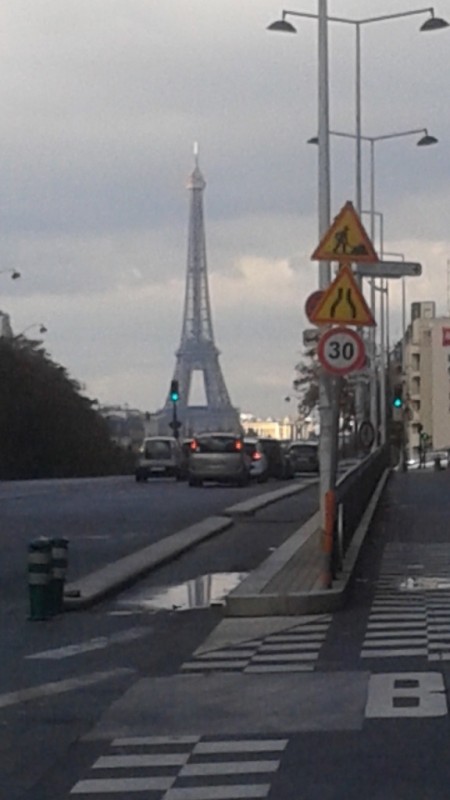
The Eiffel Tower Can Be Seen from Montparnarsse
We noticed a museum and since we mostly hit closures or long lines today and I wanted to feel like I got something useful accomplished, we went in. I didn’t even care what the museum was about! It happened to be about the French resistance movement in WWII, which is an interesting topic and one worthy of investigating. We did our proverbial scratch there. Dan did inquire about the train station and, in fact, we were somehow standing over it, even though it didn’t seem like the street was gaining any elevation from the direction we came. So we found some steps and were able to successfully navigate the machines to get a ticket.
We caught a cab home and when Dan told him we were going to St Beuve, he didn’t understand what we were saying. We would say “St Beuve merci” and he would respond “St Beuve?”. Then we showed it to him in writing and he says “St Beuve!” This has happened more than once. We or Dan says something in French and we get a blank stare. Then we say it again. More blank stare. And then again, and the person finally says right back to us what sounds exactly like the same thing we have been saying. Ah, the subtleties of getting the pronunciation right, French vowel combinations will be the end of me. Back at the hotel, we got lessons from the man behind the desk, on how to say “St Beuve.” Although we only had less than two days left, we were determined to communicate correctly with the taxi drivers.
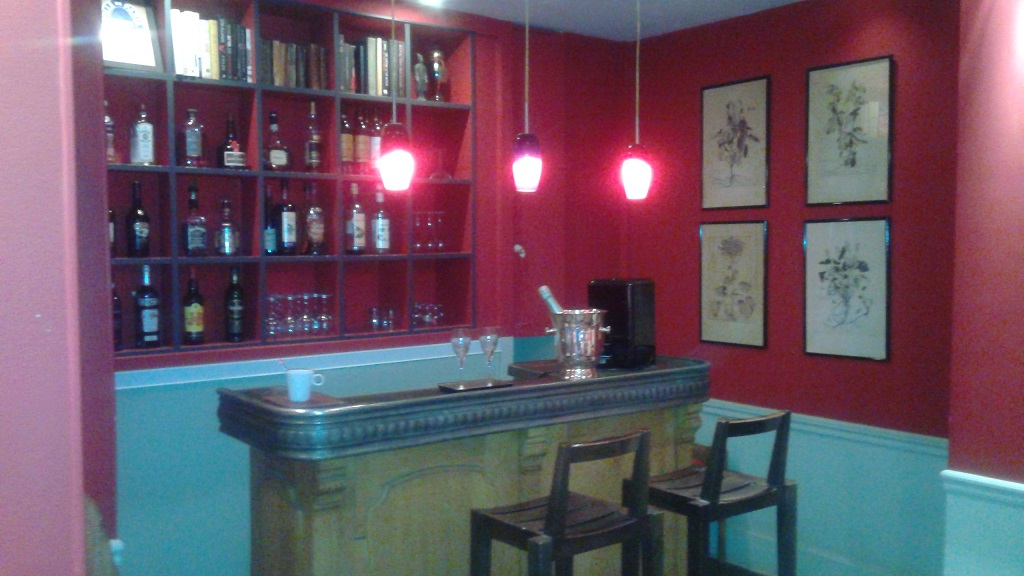
The Charming St Beuve
We got ready for what we knew would be a spectacular dinner, at Joel Robuchon’s L’Atelier. I had discovered him last year, in Patricia Wells’ book. She states that she is biased, because she has written two books with him, yet even so, she believes he is the best chef alive today. I needed no more convincing. And last year, amongst the four upscale restaurants we went to, Joel took the cake as the best overall experience.
He trades formal, for relaxed, and it totally works. Everyone sits around a bar-like counter, as opposed to having private tables. We are served by the super friendly staff who stand behind the counter. No one waiter is exclusive to a particular patron. They can all deliver and explain the food. Also, the only slot they will even take reservations for, is for when they open, at 6:30pm. Otherwise, they know they will simply be busy all night long and they don’t stick with the concept of one seating per night. The food is so incredible here, that this restaurant has been thriving for twelve years and I have no doubt that it will continue to thrive for many more. I think his idea of making superior food available without all the fuss and muss of scheduling months out and dispensing with three to four hour dinners, in favor of two (ish) hour dinners, may have caught on in Paris.
If I haven’t mentioned before, the cab drivers in Paris are about as polite as they come. They are not rushed, and they NEVER dispense with the proper bonjour monsieur, bonjour madame. Just like table setters are professionals in France, it appears that cab drivers are as well. Dan told him “Rue Montalembert , St Germain”, and he wasn’t sure where that was. I stated “L’Ateliier de Joël Robuchon” and he nodded and we were off. I am pretty sure everyone in Paris knows where it is.
We arrived early and since the doors were shut, we took a little walk. By the time we got back, there was a crowd of people waiting to get in. Since we had been there first, I was pretty determined to walk in first. The doors opened and we were all escorted in. Half a dozen waiters stood behind the counters, smiled and greeted us eager diners with a bonsoir, bonsoir, bonsoir. Dan and I were brought to the far end of the bar and our seats gave us a splendid view into the open kitchen. The show had begun, and we had the perfect seats to watch it.
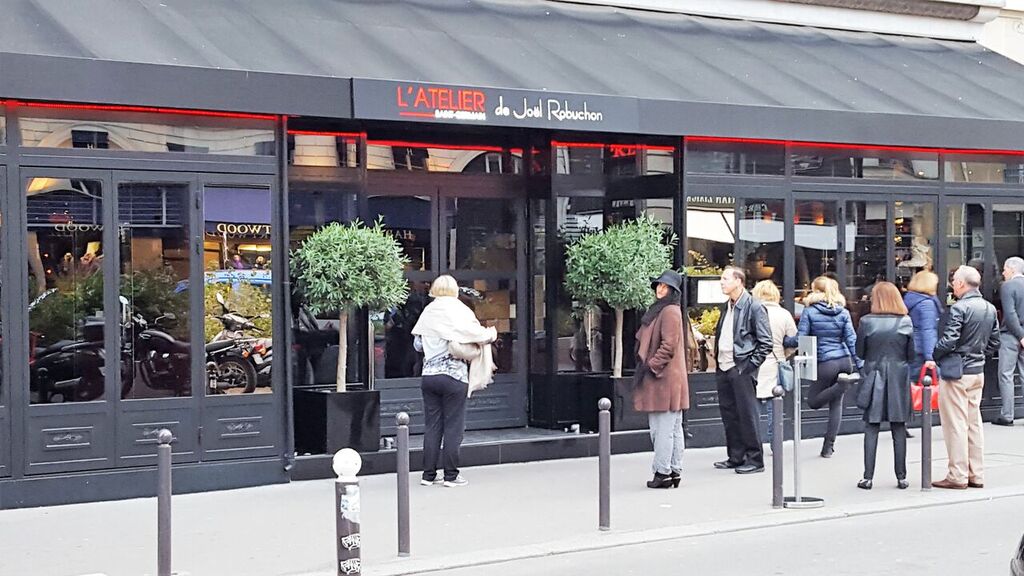
I Was Set on Being First to Enter L’Atelier
We went with the tasting menu, knowing Joël’s skills were more than worthy of showcasing. Actually, it would be more accurate to say that each course is a delight and a surprise and magnificent and food worthy of the gods. Joël is far enough down his career as a chef that he no longer is cooks at his restaurants. He has 25 of them, spread out all over the globe, and currently, his role is maintaining his empire. He does however go around to all of his restaurants, each quarter, and create the menu. He doesn’t even know what he is going to create, until he gets there. He tells his chef to have whatever is in season available and when he arrives, it takes him one or two days, and then the new menu is set for three months.
This meal is undoubtedly worthy of a bite by bite description, but instead I am going to highlight just some of the dishes, and focus on the experience of the restaurant as a whole.
They served us an amuse bouche and it was at this point, Dan got talking to the sommelier. He asked us where we were from and Dan told him États-Unis, Oregon. He smiled and said “Super, Oregon has some wonderful wine.” We on da map!
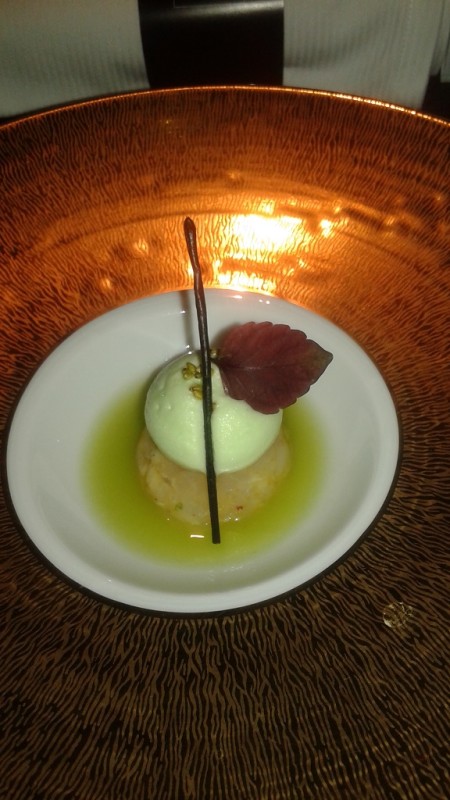
The Amuse Bouche
Our first dish from the tasting menu was a crab dish that was layered with an egg preparation and cream layer, topped with caviar and some decorative yellow and green and orange dots and a borage flower. We were instructed to put our spoon in all the way, and consume all the layers at once, as the flavors and textures complemented each other. It’s not the daintiest way of eating it, but we followed instructions and it was rich yet well balanced, each and every bite a sumptuous experience.
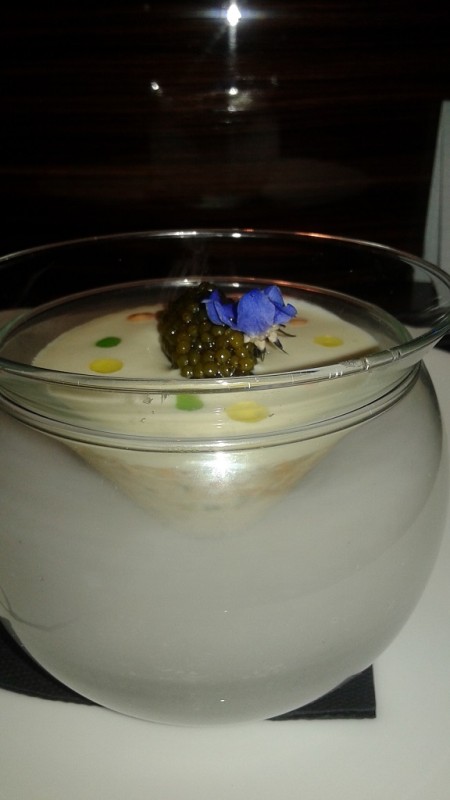
Crab and Caviar and Cream Sauce — Oh My
The next dish was a chestnut soup. It had a celery cream on top of it, along with a thin cracker, laid just so in the small dish. Chestnut is rarely used in the states and it’s too bad, because it tastes incredibly aromatic and intoxicating. I wondered if it used to be eaten more widespread before the Chestnut Blight killed all the chestnut trees in the Eastern United States. We had chestnut soup last year here and it had a celeriac root sauté, with bits of foie gras. I was seeing how a chef is presented with the same ingredients year after year and he strives to have enough consistency to honor the staple ingredients of the region At the same time, he may also want to switch up the flavor combinations and/or presentation. My guess is that he personally has a need to stay creative, as I doubt that any patron, other than me recalls if he used celery cream or celeriac sauté.
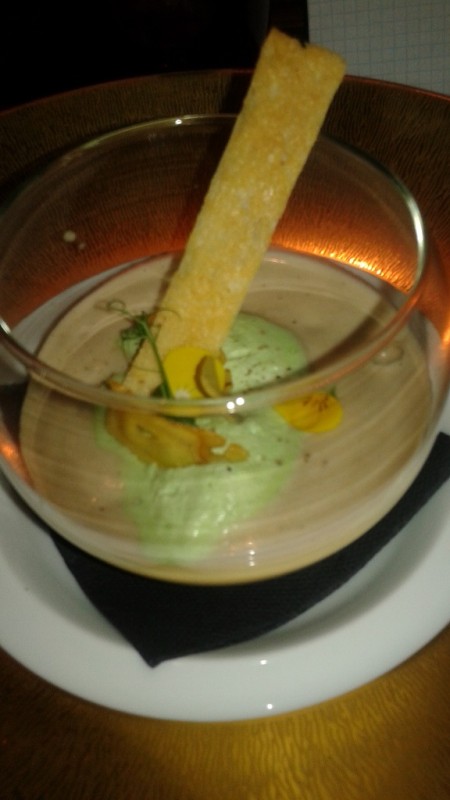
Cardamom Elevates This Chestnut Soup to Something Divine
By now, we have observed chef’s different styles and strengths and we have decided Joel’s forte is combining textures. Two of the first three dishes had layers of some sort or different components that were supposed to be eaten together to maximize the flavor and feeling in the mouth. I believe he prepares each component on its own, to showcase the main ingredient, but he wants us to feel something smooth with something textured, or something warm and creamy with something cold – to create some sort of symphony in the mouth that can rival Beethoven’s 5th.
A slice of foie gras was the focus of another dish. On it, was a long slice of green, sour apple, rolled up, and placed atop the duck liver. The apple was a brilliant red that it acquired by being soaked in hibiscus, and it gave it a dramatic effect for sure. There was a thickened hibiscus juice used to decorate the plate, and my guess is that the acid is a compliment for digesting the foie gras. Joël has mastered combining flavors and textures one would not normally put together. Clearly, he has a sense (or is willing to go through trial and error many, many times), to find out what flavors marry.
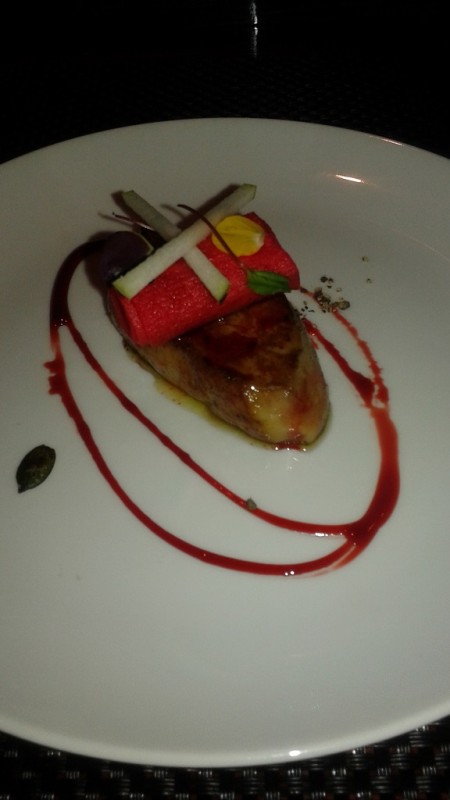
The Apple and Hibiscus Cut the Rich Foie Gras
The entire time, we were just kvelling that we had such fine seats to this incredible show, The Art of Food, up close and personal. We watched the kitchen in a constant state of flurried action and the wait staff serving the influx of people (since the restaurant was immediately filled to capacity). Without a doubt, this was a well-choreographed production. After having some lackluster meals, we could appreciate even more what it takes to coordinate this type of production. The chef stood at one island where a lot of tickets hung in front of him. He was calling out orders with authority to perhaps the other ten people working in the kitchen. They would respond by saying “chef” or “oui chef.” Now there was so many orders being given, it was at the point where who was doing the talking (the chef or the cooks) was indistinguishable. I am sure they have a very well buttoned up system to understand who the orders are directed at, but as observers, we were clueless. The chef was strong and authoritative (and young!), but also there was something personable and approachable about him. He inspected each dish before he allowed it to be served. Some of the more complicated dishes, he helped to create – placing a razor thin black truffle just so and removing an errant dot of sauce. Nobody could pull the wool over his eyes (not that anyone would even want to!).
We had gyoza next. I think my limited experience with gyoza has been frozen blobs my parents picked up at Cosco. Eating the authentic version was a religious experience! The two gyoza swam in a bath of hibiscus broth and were topped with shiso leaves. I am not sure if the French use hibiscus for its health benefits or just for the color (it is the bioflavonoid rich constituents that concentrate the medicine), but from purely an experiential perspective, the dish was eye catching and left you wanting more. This dish speaks to Joël’s Asian influence. He has traveled the world extensively studying food and he has great respect for the precision and artistic approach of Asian cooking.
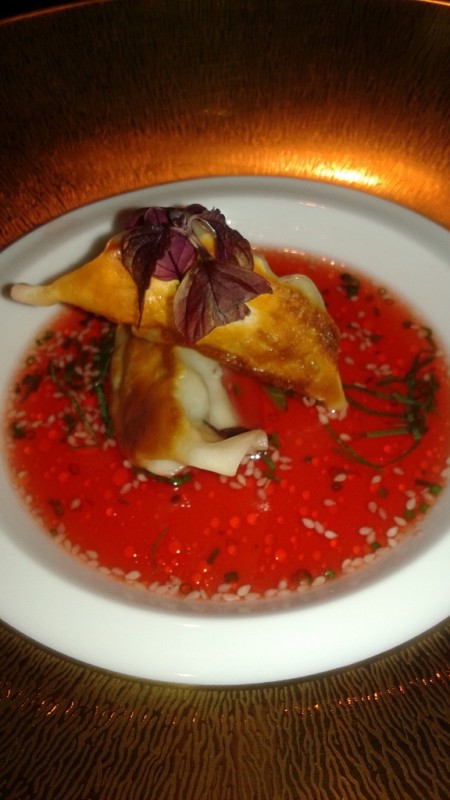
Joël’s Travels to Asia Influence His Menus
The wait staff was friendly and part of me wanted to just hog up their energy and talk about food, but out of respect, I controlled myself. I did however inquire as to what were their sources of fat. Butter from Brittany and olive oil from Provence. Now having visited both of those places, I can say that Joël is employing some of the best fat available on the market. He is originally from Poitiers, which is butter country. And it is understandable that for some dishes, he prefers have the consistency or flavor of oil.
Dan asked why everyone was repeatedly saying chaud. The waiter explained that while chaud means hot, that they use the term more broadly in the restaurant world. It signifies that you are coming up beside or behind another person and be aware, to avoid catastrophe. This is a small restaurant and the passages for walking are very narrow, which explains why we had heard chaud called out, literally a few hundred times.
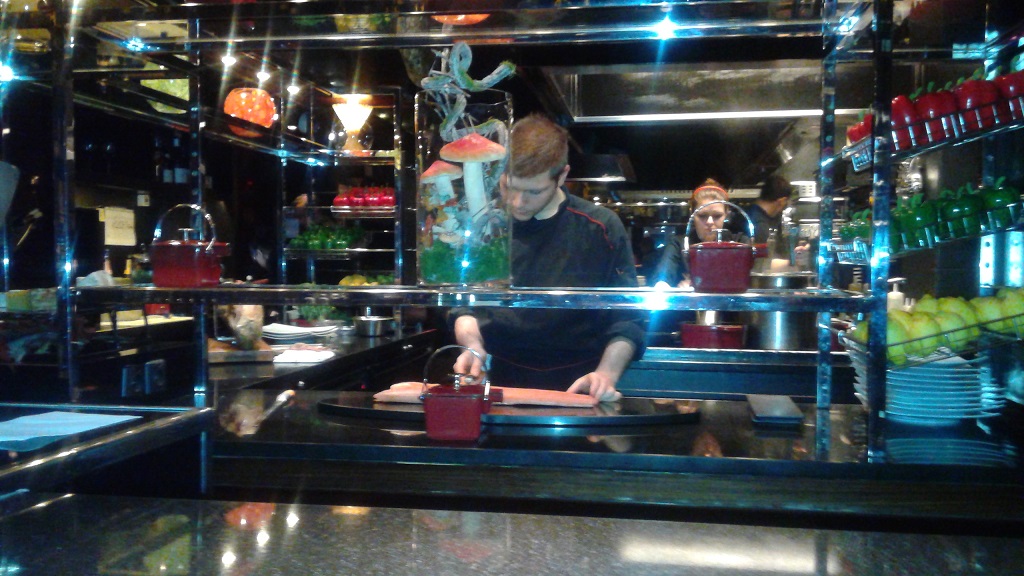
An Open Kitchen Gave us Quite the Show
One more quick question- what is the name of the chef tonight? He is Olivier Barre, and he is the sous chef. The chef does not work on Sunday. We wrote down his name, because one never knows when he will branch out someday and we will want to patronize his work.
In another moment, a whitefish dish followed. We have had this type of fish at pretty much every restaurant since we’ve been here. It clearly is abundant and in season. Honestly, the best preparation of it was our first night at Kei, since it was crispy which added depth to an otherwise plain tasting fish. This dish, did compensate with the other components. It was laid on a bed of broccoli cream, had a fish foam, and bright yellow violet flowers atop a veined cracker made of squid ink and the whole dish was laced with a fish jus. We asked about how the broccoli cream was made, since it wasn’t “creamy” if you will. The waiter explained it contained no dairy and it was made by injecting carbon dioxide into it, which is how the foams that are so popular in haute cuisine are also made. Absolutely delectable.
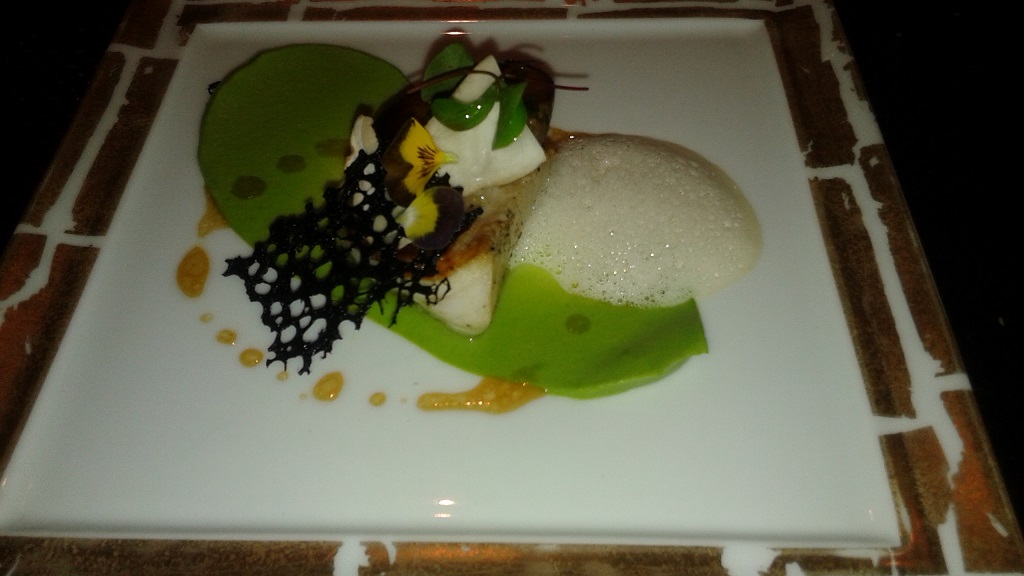
Squid Ink Crackers Is Almost Over the Top in Creativity
The food kept coming and our main dishes arrived. Dan had the smallest and most tender lamb chops I have ever seen (except for when he ordered them last year here), with a few greens, and herbs aside it. Again,à jus finished the dish.
I had black angus à la plancha, with caramelized shallots in a juice with black cardamom and tarragon. Now as the waiter isat my plate down, the stack tippeds over and it was no longer the work of art it was intended to be. I was honestly fine with this, but since the waiter noticed me taking pictures of each dish, he immediately said he was bringing it back to the kitchen to be reconstructed. I didn’t argue, knowing that ze details are of utmost importance to the French. We watched as the assembly line got to work to recreate the dish on another plate. I believe they used the same steak, but for the other components they started anew.
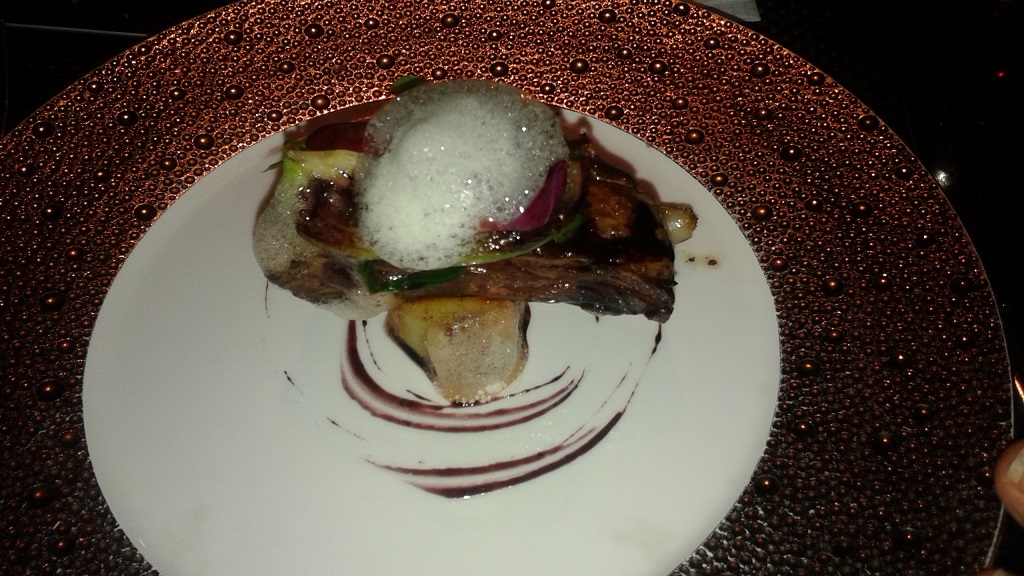
A Very Dramatic Display of Juicy Black Angus
Joël skipped the cheese course, which was no problem for us. We won’t tell anyone, if you don’t.
They brought one dessert and then another. The second one, I recognized immediately as something we had eaten last year. Then the waiter told us this is the signature dish and it has been served here every night since the restaurant opened up twelve years ago. They call it The Chocolate Temptation, and the way it is constructed completely epitomizes Joël’s style, having several layered textures, that need to be eaten together in one bite, to gain the full effect. A creamy chocolate ganache sat in the bottom of the pyramidal shaped bowl and on top of it were iced cocoa nibs and then a thin layer of chocolate coats the bowl with a hole in the middle. Peeking out of the hole is the cacao nibs and it was sprinkled with ground up oreo cookie. The pyramid bowl sits inside of a glass and in the bottom of the glass is more ground up oreo cookie, just in case you didn’t already have cocoa overload. The solid chocolate ring has ten dots around it, alternating bits of raspberry and mango sauce, the red and orange lightening the effect of this super rich dish. On a whole, I did an excellent job of not consuming much sugar on this trip so I was going to reward myself and enjoy every bite of the chocolate temptation. It was SO GOOD. Really, I was even having thoughts it might be okay to die now.
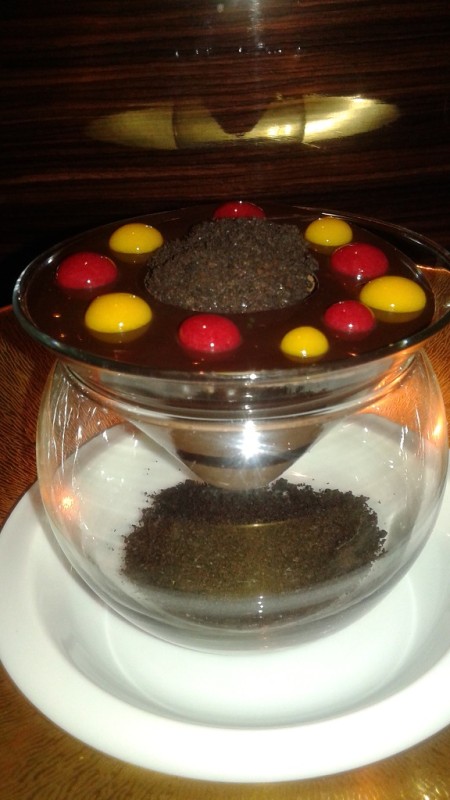
Joel’s Signature Dessert – Served Every Night Since L’Atelier’s Inception
I guess we had gotten chummy enough with the waiter and more importantly, our genuine interest in the food was apparent, and he inquired if we might like to meet the chef. We were excited, but played it cool as a cucumber. He brought the chef over and we let him know what a truly incredible meal this was – the presentation, the taste, the timing, the service – they had reached perfection and we respected the work they do in such a big way. We could tell that the chef was honored by our enthusiasm.
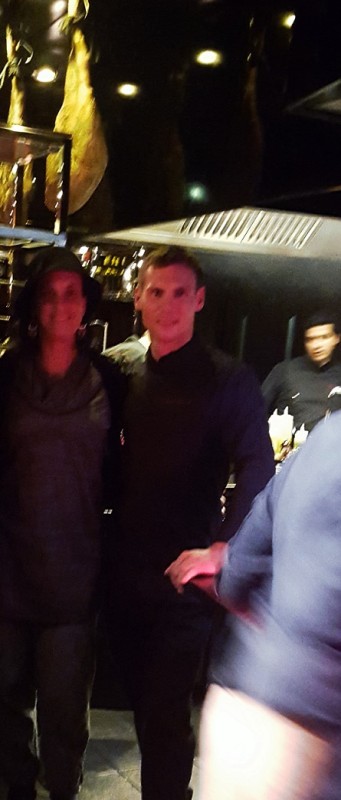
Hobknobbing at Joël’s
We were getting ready to go (sadly- I think we had reached our limit nursing our tisane drinking, and paying the tab, and noticed that the second seating was already getting their food) and the waiter asked if we would like to tour the kitchen. We couldn’t believe it!! Really, I just couldn’t believe it, the kitchen was in the heat of the action, and they were willing to squeeze two more people in there to make their day. Dan and I both knew how to contain our elation and we graciously accepted. We were personally escorted in and we said chaud a few times when we were getting close to others. The electric feeling of a kitchen like this was contagious. We patiently waited while the chef worked on a couple dishes. Both of us were astonished that he was willing to take time away from his duties to welcome us. He explained that L’Atelier was built on the concept of Spanish tapas and he showed us how the kitchen was divided for different tasks. One of the staff snapped a picture of us and we expressed our gratitude and said au revoir, walking on clouds.
Without a doubt, it’s the food that creates the magic. We set our intentions to have a gastronomic tour, we researched, made notes, dreamed, winnowed down, and stay engaged throughout the entire process. And I strongly believe that our interest and respect for French gastronomy stood out to our waiters. On our trip, seven of the twelve restaurants we went to, we met the chef or got some special tour. Jean-Luc Rabanel’s was the only restaurant where this was standard practice, the rest, special accommodations were made on our behalf. I have always said, that sharing a passion for food is one of the best ways to build community. I believed it when I first said it years ago and I believe it tonight.
Later on, Dan asked me if I noticed the French diners at L’Atelier looking at us when we went into the kitchen. I had not noticed actually. He told me their eyes were large and they were pointing at us, wondering if we were some sort of rock stars. And in our own minds, yes, we were.
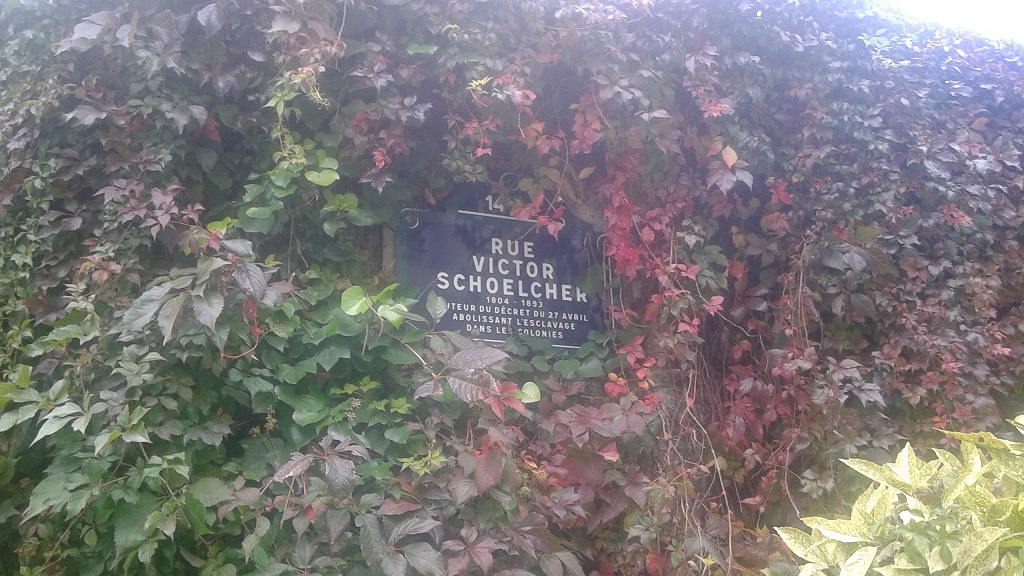
Autumn in Paris Is Colorful and Abundant
 ?>/images/logo.520x200.jpg)